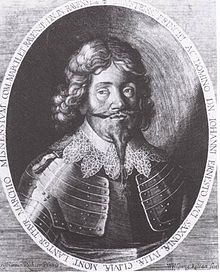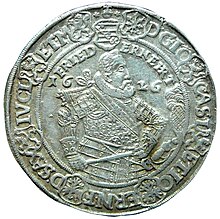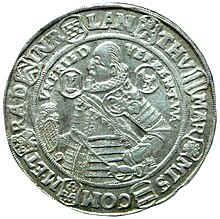Johann Ernst (Saxony-Eisenach)
Johann Ernst (born July 9, 1566 at Grimmenstein Castle in Gotha ; † October 23, 1638 in Eisenach ) was Duke of Saxony-Eisenach and from 1572 (nominally, initially under guardianship), from 1586 with independent regency (together with his brother Johann Casimir ) also Duke of Saxe-Coburg (until 1596). From 1633 he ruled again in addition to Saxony-Eisenach and the Duchy of Saxony-Coburg, this time alone. He came from the family of the Ernestine Wettins .
Life
Johann Ernst was born as the youngest son of Duke Johann Friedrich II., The middle one, and his wife Elisabeth , a born Countess Palatine near the Rhine . His grandfather, Johann Friedrich I, the magnanimous , had still held the title of Saxon Elector , but lost the electoral dignity to his Albertine relative Moritz of Saxony after the battle of Mühlberg in the Schmalkaldic War . Since then, his father sought to regain the electorate for the Ernestines. For this purpose he took an outlawed knight , Wilhelm von Grumbach , into his home, which ultimately led to the imperial ban being imposed on his father too . Only one year after his birth, his father's castle was besieged and finally conquered by the troops of Elector August von Sachsen . His father got into imperial captivity (cf. Grumbachsche Handel ) from which he was never to escape during his life. His mother, his two brothers and Johann Ernst had to flee Gotha. They were initially accepted by his uncle, Duke Johann Wilhelm von Sachsen-Weimar , who also took over the guardianship of the princes and the administration of the territories Johann Friedrich the Middle. After a short time in Weimar, Johann Ernst lived with his mother and brothers in Eisenach and Eisenberg .
In the meantime, however, his uncle, Johann Wilhelm von Sachsen-Weimar, had fallen out of favor with the Kaiser . At the instigation of the emperor, the Reichstag in Speyer decided in 1570 to reinstate the three sons of Johann Friedrich the Middle as their father's rights.
In 1572 his older brother Friedrich Heinrich died of typhus . At the end of the same year, the decision of the Reichstag of Speyer was implemented through the Erfurt partition agreement . His father's territories were again removed from the Duchy of Saxony-Weimar, and the new Duchy of Saxony-Coburg-Eisenach was created from them . Johann Ernst was appointed regent of the new country together with his older brother Johann Casimir, but due to their minority initially under the tutelage of the three secular electors Friedrich III. von der Pfalz , Johann Georg von Brandenburg and August von Sachsen, who also took over the leadership of the regency over Sachsen-Coburg-Eisenach.
Duchess Elisabeth left for Wiener Neustadt in the summer of 1572 , where she lived with her own court with her husband, who was still in imperial captivity. The two young princes, Johann Casimir and Johann Ernst, moved to Coburg , the future capital of the new principality. At the age of only six, Johann Ernst was permanently separated from his two parents and entrusted to the upbringing of strangers. His guardians signed the Agreement Formula of 1577 and the Agreement Book of 1580 in Johann Ernst's name .
From 1578 Johann Ernst attended the university in Leipzig together with his brother . After his older brother married Anna von Sachsen, daughter of the Saxon Elector August, in 1586, the guardianship was lifted and Johann Casimir and his brother took over the independent regency of Sachsen-Coburg-Eisenach. Johann Casimir and Johann Ernst ruled the principality together for the next ten years, although Johann Casimir, as the older brother, had the main responsibility for the government.
During the common reign, a common coinage began, which was continued after the separation until 1633. Several Eintrachtstalers were minted as Reichstaler in accordance with the Reich coinage system.
In order to move away from his brother, Johann Ernst built his own castle from 1587 in the small community of Marksuhl , which was in the Eisenach part of the principality. From 1590 Johann Ernst withdrew completely from the government of the duchy, he agreed with his brother that he should rule the duchy alone for five years. When this time had passed, he finally agreed a new division of the country with his brother in 1596. The Duchy of Saxony-Eisenach was separated from Saxony-Coburg, while Saxony-Coburg remained with Johann Casimir, Johann Ernst received Saxony-Eisenach as an independent principality. For the first time in its history, Saxony-Eisenach became its own independent political unit within the Holy Roman Empire . In the same year, Johann Ernst moved his residence from Marksuhl to Eisenach, the new capital of his country, where he initially lived in the Landgrafenhof and began building his own castle.
In 1598 Johann Ernst set up a state government and a consistory for his duchy . In 1633 his brother, Duke Johann Casimir von Sachsen-Coburg, died childless. Johann Ernst therefore inherited Saxony-Coburg, until his death in 1638 he ruled both countries in personal union, but kept his residence in Eisenach.
family
Johann Ernst married Elisabeth in 1591, born Countess von Mansfeld-Hinterort . However, she died in 1596 with the birth of his only son, who also died shortly after the birth. In 1598 he married Christine , a born Landgrave of Hessen-Kassel, in his second marriage . The marriage was happy but remained childless.
With the death of Johann Ernst, the older line from Saxe-Coburg and Eisenach was extinguished again. His principality was divided under the remaining Ernestine lines of Saxony-Altenburg and Saxony-Weimar .
literature
- August Beck: Johann Ernst, Duke of Saxony-Eisenach . In: Allgemeine Deutsche Biographie (ADB). Volume 14, Duncker & Humblot, Leipzig 1881, p. 364 f.
Web links
Individual evidence
| personal data | |
|---|---|
| SURNAME | Johann Ernst |
| BRIEF DESCRIPTION | Prince from the Ernestine line of the Wettins |
| DATE OF BIRTH | July 9, 1566 |
| PLACE OF BIRTH | Gotha |
| DATE OF DEATH | October 23, 1638 |
| Place of death | Eisenach |



